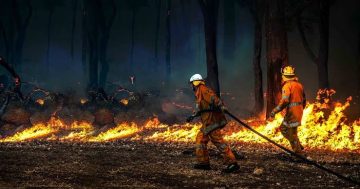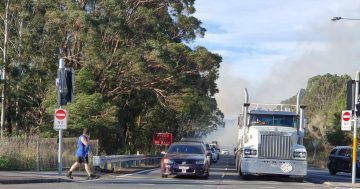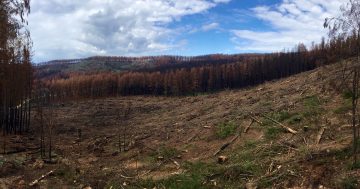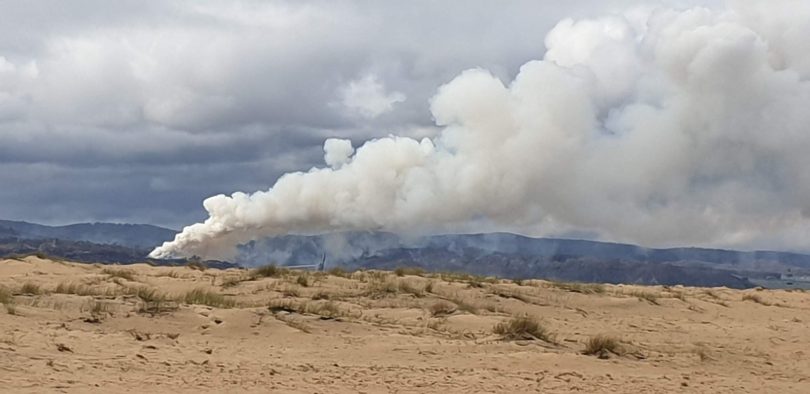
Smoke from the Border Fire and Eden Chip Mill fill the skies. Photo: Mia Maze.
As fires continue to burn along the coast from Bermagui to Batemans Bay, and into the Shoalhaven, a packed hall of Nethercote residents heard that resources remain understandably stretched across the state.
And as coastal communities face months, not weeks of dealing with “this beast hanging around their backyards”, the RFS has again come to the rescue, with timely advice on managing anxiety and “fitting this fire into our lives”.
Bega Valley Shire’s Mayor Kristy McBain and Acting General Manager Anthony McMahon attended the meeting where NSW RFS Far South Coast Community Safety Officer Marty Webster laid out his overview of the situation for the community, and fielded some tough questions.
As far as much-needed rainfall goes, all indications are that the promised rains are not going to be significant for the South Coast, and certainly not enough to put out the fires.
Mr Webster said it will be “more like 1 to 5 mm, with some potential for isolated storms”.
“There are high fuel loads in the forests, of course, but the critical thing is that they’re all drought-affected at the moment. The fires run through hard and there is nothing left on the ground,” Mr Webster said.
Suggestions for managing anxiety include taking regular breaks from news and social media. Mr Webster suggested instead that fire ‘danger ratings’ are the thing to watch.
“On low-danger days take a break, relax a little, then as the rates increase, start to monitor conditions,” he said, warning that communities will continue to see puffs of smoke, and that smoke will flare into large plumes until we receive decent rainfalls.
“It’s not going away. We are not going to take our eyes off it, but it is now a reality. We’ll be working on the edges, blacking out edges, doing whatever we can, but you’ll be living with a smoky environment for some time to come.”
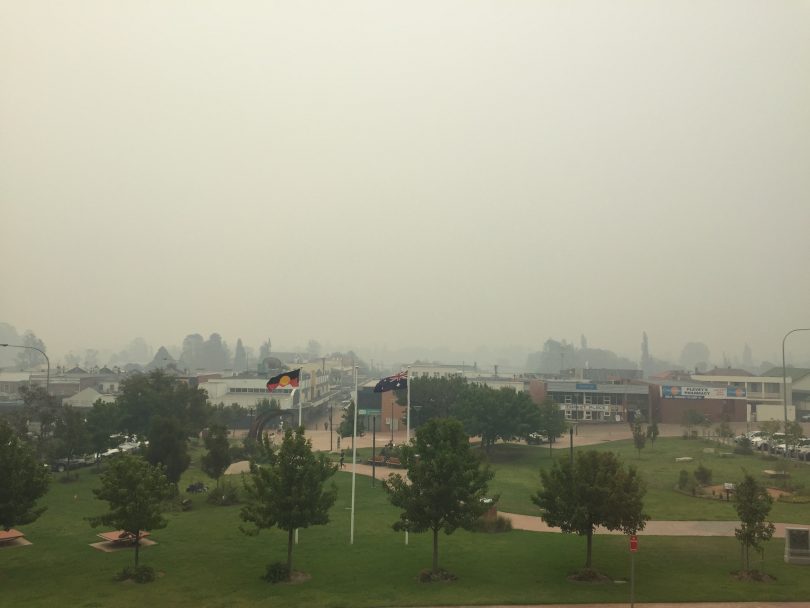
Smoke is not leaving the Bega Valley any time soon. Photo: Lisa Herbert.
The first question put paid to false information that’s been circulating for weeks: “Why is the RFS not allowing back burning?”
“Where does that notion come from?” returned Mr Webster. “We look at the best technique to get the job done. Sometimes that will involve back burning, but that needs to be really carefully planned, especially given how dry the forest is at the moment.
“Back burning is a really high-risk activity, and sometimes all it does is bring fire closer to us.
“Unless we’ve got adequate resources, to make sure we don’t lose that back burn, we won’t be putting one in here. But [to say] that we’re not back burning? That’s just not true.”
Regarding criticism around State support for RFS Webster pointed out “that’s a pretty flash truck sitting out there, you know. That’s provided by the State Government, that’s not coming out of volunteers’ pockets, and we did extensions to the station here this year, so yes, there is support”.
Brigade resources come back to levels of recruitment, he said.
“If we can say we’ve got 22 new volunteers that can’t all fit on the one truck, then we’ll look at getting another truck in there, but we can’t put a second truck in Nethercote if it’s going to sit there dormant.”
There is more aerial activity in the area and Australian Defence Force personnel are also in large numbers, providing logistical support, road clearing, and replenishing water used through firefighting.
Water bombers are staying in the area and Anthony McMahon said that every day presents a different risk analysis.
“A lot of lines have been prepared, and we are continuing with that work as well, identifying those properties most at risk, and making sure they are well prepared as well as bolstering containment strategies throughout.
“But the reality has been, with the scale of what we’re seeing and what is occurring, they [the RFS] can’t do it all. The reason the message to leave comes out is to reduce the burden on resources.
“Around the 4th January there were situations where we had people hurt who were isolated for over 24 hours because no one could get to them in any way, the air was full of smoke you couldn’t get a chopper in,” he said.
Mr Webster explained: “I’ve seen fires jump 60 metre wide breaks and completely disregarded the Princes Highway, so please don’t think brushing up old hut trails is going to save us all.
“We are not walking away from it, we have a number of different strategies, and we hope Plan A comes off. If it doesn’t, we have Plan B and Plan C, but with what I’ve seen up and down the East Coast this season? The only fires break I’ve been able to rely on is the Tasman.”
If you are in trouble or under threat of fire, call Triple Zero, 000
Visit the RFS website for information on fire safety and fireproofing your property
Download the Fires Near Me app to monitor fires in your area.







